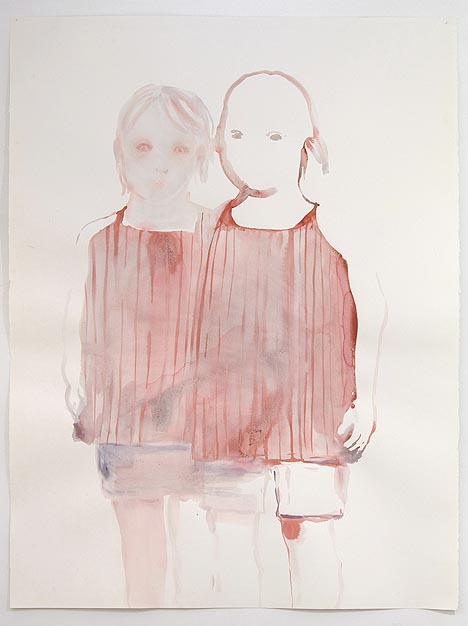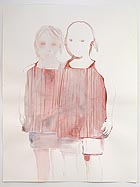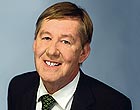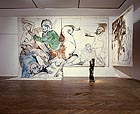
translated and summarized by: Liz Wollner-Grandville,
English summary September 1 - 7
Galerie im Traklhaus: figurative illustrations
Option presence
Lóránd Hegyi and Dietgard Grimmer chose a selection of works by Austrian and French artists under the aspect of “nomadic narratives”. The outcome is currently shown at the exhibit “Figurative illustrations”, which is clearly influenced by Jean Francois Lyotard’s post-modern rejection of a universalistic narrative style.
Although there is consensus that the time of big narratives are long gone, an abundance of counter-narratives become visible – mainly on account of their tendency towards the figurative - in the juxtaposition of illustrations by Iris Andrasheck, Rebecca Bournigault, Maria Bussmann, Barbara Eichhorn, Gunda Gruber, Francoise Pétrovitch, Bartehélémy Toguo, and Jean-Luc Verna. Undeniably a mix of different approaches enhance the quality of an exhibit. Barbara Eichhorn’s illustrations are characterised by infringing on intimate fields of life, which do not necessarily narrate her own story. In contrast to the idyllic semblance made by the encounter of dog and man, this has nothing to do with the passions of a dog lover, but with emotional perversions, which develop through the increasing loneliness and isolation of an individual. The narrative track is laid out in titles given to the large format ballpoint works: “Forbidden Love” (2007) or “We forgot to kiss our love” (2008).
Exciting parallels surface in the masked faces of Iris Andraschek’s and Rebecca Bournigault’s works. While Bournigault chose photographs and videos as the source material, Iris Andraschek shows illustrative sovereignty by counteracting absurd scenarios with aphoristic political texts.
Today, illustrations are faced with enlightening insights into the complexity and into programmatic challenges, which are depicted by linking psychological experience, socio-political reality, and fictitious-imaginative situations.
Galerie im Traklhaus
5020 Salzburg, Waagplatz 1a, until 13. 09. 2008
www.traklhaus.at
Kunsthalle Wien public space Karlsplatz: Gottfried Bechtold – Our man
Everyone can be a politician
Karlsplatz is one of Vienna’s most frequented locations. Whatever is positioned here, will be seen by thousands of drivers, bikers, pedestrians or people using public transport. Just recently a special poster, which could easily be part of the currently ongoing election campaign, has been temporarily posted at this location. The placard includes all the features of an election poster: the phrase “our man” next to a portrait photo, depicting a well dressed man attempting to conjure a convincing and trustworthy smile onto his face, a face which has not yet been overused by the media. He holds his head slightly tilted as if he himself wasn’t even convinced of what he was trying to convey. And the political party for which he is campaigning changes twice a week! The best part, however, is the indication of which party is campaigning: it changes twice a week.
Gottfried Bechtold’s talent cannot be commended enough – not only did he himself concoct the hoax, it is his face on the poster. The phenomenon addressed by Bechtold is well known: the moment the election campaigns begin, billboards are plastered not only with well-known, but increasingly with new faces. And it seems that all they have to do is smile, try not to look too intelligent, and be the likable “down to earth” type of person.
Party programs, concepts and competence are no longer important – the only thing that seems to count is having a scheme on how to reach consensus. Bechtold unmasks the primitive prerequisites for the future leaders of our country: white, preferably male, and conservative. Joseph Beuys already made it clear that everyone can be an artist, now Gottfried Bechtold reminds us that everyone can be a politician. “Our man” reflects nothing less than the revival of archaic scum rooted deeply in our social values. Inevitably this leads to the conclusion that this is what we deserve. But actually why not? Gottfried Bechtold for President!
Kunsthalle Wien public space Karlsplatz
1040 Vienna, Treitlstrasse 2, until 12. 10. 2008
www.koer.or.at
Künstlerhaus Wien: Alfred Hrdlicka – The Titan and the stage of life
The uncomfortable Titan
This exhibit is a beautiful and poetic homage to one of the greatest Austrian post-war artists. The range of the exhibit spans from monumental sculptures, such as the reduced stage set of Intolleranze by Luigi Nono, to small format graphics, like the cycle Wiener Blut, which deals sarcastically with the absurdity of banning pornography. The huge works for the stage set of Peter Eschberg’s Faust production in Bonn (1982) are also highly recommendable.
But it wouldn’t be Alfred Hrdlicka if one wouldn’t also feel highly uncomfortable. For example when faced with the huge painting “Salvation Final Solution”, which takes up the murderous horror of the Nazi atrocities. Hrdlicka’s works always accuse or scream out against the injustice and cruelty of the world.
This exhibit successfully presents the entire spectrum of one of the most consequent and headstrong living artists. His memorial against war and fascism at Vienna’s Albertinaplatz is well known. However, his illustrations and paintings are rarely shown in collections and museums, where they would earn to be displayed next to works by Rainer, Nitsch, or other Austrian stars.
With his sculpture Orpheus I (1963), which is currently shown at the Albertinaplatz, the uncomfortable Titan definitely secured his position among the best sculptors of the 20th century.
Künstlerhaus Wien
1010 Vienna, Karlsplatz 5, until 21. 09. 2008
www.k-haus.at
MAK: Focus on artists # 4: Franz West: Sit on My Chair, Lay on My Bed
When form follows function
Franz West’s furniture designs have a high recall value ever since the documenta X in Kassel, where numerous variations of West’s Doku chair could be found in the dX exhibit hall. The current exhibit at the MAK “Sit on My Chair, Lay on My Bed” displays a synopsis of West’s work. Artmagazine editor Barbara Vischer is the curator of this show, which, as the title suggests, is conceptualised as an invitation to actually use the individual objects.
West’s furniture designs present themselves in unusual forms and materials, sometimes combined with metal or plaster, and which focus on the relationship between human beings and the environment. Be it the lounge chair with its linen cover and integrated headphones or the metal seat sculpture Eo Ipso: the design, as well as the material, are often disconcerting, while they are user friendly and thereby support the applied aspect of art and everyday life.
The exhibit was jointly organized by Peter Noever and Franz West. West’s irony is present in all of his works and points to the necessity of leaving one’s normative viewpoint out of everyday life.
MAK-Applied Arts/Contemporary Art
1010 Vienna, Stubenring 5, until 28. 09. 2008
www.mak.at
Mehr Texte von translated and summarized by: Liz Wollner-Grandville


 Teilen
Teilen





